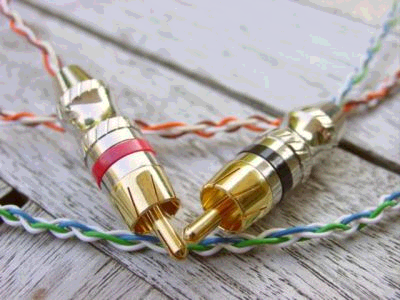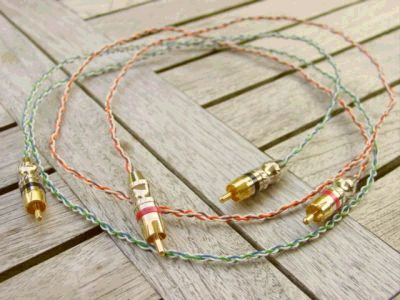4-Play <span lang=NL style='font-size: 14.0pt;'>Braided Interconnect with four wires</span>
<div align=center style='text-align:center'><span lang=EN-US>
</span></div>

<span lang=NL>Introduction</span>
<span lang=NL>Almost every DIY forum has threads discussing the same topic: How can we use UTP (cat-5) cabling in our cable projects. I've seend power cables made of UTP (many parallel), and speaker cable made out of several parallel cables, but I did not yet see many interconnects based on UTP cable.</span>
However, as UTP provides a reliable physical transport for high frequency networking in many critical environments, why would UTP not be suitable for digital or even analog interconnects? The individual 8 wires inside the cable have a small diameter and therefore HF effects such as skin-effects etc. should not play a role in the audio range of signals. On the other hand, many hard-core audiophiles suffer from the same disease: If it ain't expensive, it ain't good. And since UTP cable is dirt cheap (relatively spoken), there is no ground whatsoever to consider these cables in your €10,000 + Hifi setup.
Maybe I should have written this paragraph in a totally different style: Explaining that this interlink is made out of exotic copper with a purity of 99.9999999 % which is made during full moon. Of-course I made the interconnect using fine silver solder of Siltech and a soldering iron with it's own audiophile powercord heated to 290.3 degrees Celcius exactly and blessed by the pope himself.
Anyway, I had the idea of making an interconnect which is super low cost, sounds very well for the money when made yourself will cost you € 7.50 max.
<span lang=NL>Construction details</span>
This is how I made the 4Play interconnects:
Take 1 to 1.5 meters of UTP cable of good quality
Remove the (grey) jacket, which leaves you with 4 pairs of wire (Orange/white, Brown/white, Blue/white, Green/white)
Untwist the 4 pairs and straighten the resulting 8 wires carefully.
Make a 4-way braid of 4 of the 8 wires. I took the Orange and Brown together for the signal and two whites for the ground return. For the left channel I used the blue and green wire for the signal and also two white wires for the return. Look at the QuaDraad project for a description of the twist/braid process.
At the ends of the cables, take the two coloured wires together and solder them to the central pin of the RCA connector. The two white wires are taken together and soldered to the ground socket of the connector.
After soldering the two black connectors to the green/blue cable and the red connectors to the orange/brown cable we're done.
It sounds simple, and that's probably because it is simple. Only the braiding process itself takes a very long time and is boring work. Looking back it took me probably 3 hours before I completed a pair of interconnects (including connectors etc.) and that's far to long to be economical in any way. Fortunately this is hobby stuff and I do it for fun (duh).

<span lang=NL>How does the 4Play sound?</span>
I can be brief here, the sound is very good. For a start I have connected the 4Play to the Pioneer DVD-Audio player that has two line-out for stereo (front channels). The first connector pair was already connected with a vdHul Second interconnect, so the 4play was connected between the second output pair of the player and a free input on the Marantz amplifier.
The first half hour I was, and with me two other listeners, capable of distinguishing the 4Play in 5 of the 6 cases. The other two listeners are music lovers but not audiophiles at all, and had no idea what I was trying to prove. They just noticed differences just like I did.
After that half hour it became increasingly difficult to keep the two interconnects apart. That's a great compliment for the 4play which costs are at least 20 times less than the vdHul. Not a bad result at all, so I'm planning to use this interconnect for alonger time in order to test the results over a longer period of time. Anyway, should I at a later stage have second thoughts about the qualities of the 4Play, I will write it down on this page.
<span lang=NL>Room for improvement?</span>
<span lang=NL>There must be. After all I made this project just for fun, from 4 cheap RCA connectors and a loose end of UTP cable. The total costs were less than € 5.00 (I think) for a stereo pair of interconnects. However, when taking labour costs into account it becomes priceless :-) With 4 thin wires it takes hours to get a pair of 1 meter interconnects, and I'm looking for a way to make it faster (or a volunteer to do it for me).</span>
The following things need further study:
Better RCA connectors, as I do think the result is worth the additional costs
I built a stereo pair of 1 meter, where for most applications 60 cm would be fine as well.
There must be UTP cat 5 or 6 on the market with Teflon insulators.
I wish you pleasure (/success) when building your own 4Play interconnects.
Wyszukiwarka
Podobne podstrony:
An%20Analysis%20of%20the%20Data%20Obtained%20from%20Ventilat
Biomass Fired Superheater for more Efficient Electr Generation From WasteIncinerationPlants025bm 422
Bleaching Water Stains from Furniture
O'Reilly How To Build A FreeBSD STABLE Firewall With IPFILTER From The O'Reilly Anthology
Estimation of Dietary Pb and Cd Intake from Pb and Cd in blood and urine
pages from xm 754sx 3
httpwww bg utp edu plartpe32006pe32006117124 (1)
Zagadnienia NoO, Notatki UTP - Zarządzanie, Semestr II, Nauka o organizacji
Postacie wody w glebie, Studia, UTP Ochrona środowiska, I rok, Semestr II, Geologia
Fizyka proj 3, Budownictwo UTP, semestr 3, Fizyka Budowli
Budowa wnętrza Ziemi, Studia, UTP Ochrona środowiska, I rok, Semestr II, Geologia
Źródła finansowanie projektów, Notatki UTP - Zarządzanie, Semestr III, Zarządzanie projektami
W.2. Podstawy prowadzenia działalności gospdoarczej, Notatki UTP - Zarządzanie, Semestr V, Podstawy
E2p, UTP-ATR, Elektrotechnika i elektronika dr. Piotr Kolber, sprawozdania
PI 23.11.2011, Notatki UTP - Zarządzanie, Semestr III, Procesy informacyjne
Tematy, Budownictwo UTP, semestr 1 i 2, budownictwo, SEMESTR ZIMOWY, inzynieria srodowiska, inzynier
W.5. Podstawy prowadzenia działalności gospodarczej, Notatki UTP - Zarządzanie, Semestr V, Podstawy
POMIAR DŁUGOŚCI I OBWODÓW KOŃCZYN GÓRNYCH I DOLNYCH, utp, Sensory i pomiary wielkości nieelektryczny
statystyka egzaminy rozwiązane, UTP, II semestr, STATYSTYKA
więcej podobnych podstron